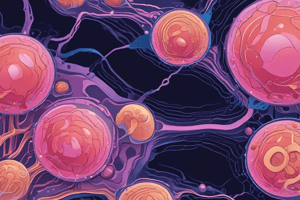Podcast
Questions and Answers
What is the primary pathway for the initial dissemination of carcinomas?
What is the primary pathway for the initial dissemination of carcinomas?
- Lymphatic spread (correct)
- Haematogenous spread
- Direct seeding of body cavities or surfaces
- Failure of angiogenesis
Which type of tumor is most likely to metastasize to the liver through the portal vein?
Which type of tumor is most likely to metastasize to the liver through the portal vein?
- Carcinoma of the large intestine (correct)
- Breast carcinoma
- Malignant teratoma of the testis
- Osteosarcoma
What is the term used to describe the process of cancer cells breaking off from the primary tumor and entering small lymphatics?
What is the term used to describe the process of cancer cells breaking off from the primary tumor and entering small lymphatics?
- Direct seeding
- Lymphatic invasion (correct)
- Angiogenesis
- Hematogenous spread
Which of the following is NOT a common site for hematogenous metastasis?
Which of the following is NOT a common site for hematogenous metastasis?
What is the term used to describe the deposition of cancer cells in the draining lymph nodes?
What is the term used to describe the deposition of cancer cells in the draining lymph nodes?
Through which of the following routes can tumor cells directly access the lymphatic system?
Through which of the following routes can tumor cells directly access the lymphatic system?
What is the term for the process of tumor cells breaking free from the primary tumor and entering the bloodstream or lymphatic system?
What is the term for the process of tumor cells breaking free from the primary tumor and entering the bloodstream or lymphatic system?
Which of the following is a characteristic of the metastatic cascade?
Which of the following is a characteristic of the metastatic cascade?
What is the term for the spread of a tumor to sites that are discontinuous with the primary tumor site?
What is the term for the spread of a tumor to sites that are discontinuous with the primary tumor site?
Which of the following is NOT a step in the invasion of epithelial basement membranes by tumor cells?
Which of the following is NOT a step in the invasion of epithelial basement membranes by tumor cells?
Which of the following carcinomas is most likely to cause osteosclerosis?
Which of the following carcinomas is most likely to cause osteosclerosis?
What is the term for the seeding of body cavities and surfaces by malignant tumors?
What is the term for the seeding of body cavities and surfaces by malignant tumors?
Which of the following is an example of a local effect of a malignant neoplasm?
Which of the following is an example of a local effect of a malignant neoplasm?
What is the term for the spread of tumor cells through the bloodstream?
What is the term for the spread of tumor cells through the bloodstream?
Which of the following is an example of a metastatic pathway?
Which of the following is an example of a metastatic pathway?
Flashcards are hidden until you start studying
Study Notes
Metastasis of Tumors
- Pathways of metastasis: 1) Lymphatic spread, 2) Haematogenous spread, and 3) Direct seeding of body cavities or surfaces
- Lymphatic Spread (LC):
- Most common pathway for initial dissemination of carcinomas
- Cancer cells deposited in draining lymph nodes, which is important for assessing disease course and selecting therapeutic strategies
- Haematogenous Spread (HS):
- Typical route for metastasis of sarcomas
- Liver, lungs, bone marrow, and adrenals are most frequently involved
- Sites of Haematogenous Metastasis:
- Lungs: occurs with a wide range of malignant neoplasms, e.g. osteosarcoma, breast, stomach, and large intestine
- Liver: common site for carcinomas of large intestine (portal vein) and bronchial carcinoma
- Bone: can cause destruction of bone (e.g. bronchial carcinoma, breast carcinoma) or production of dense bone (e.g. prostate carcinoma)
- Brain: can cause problems within the brain and meninges (e.g. bronchial carcinoma, breast carcinoma, testicular carcinoma, malignant melanoma)
Invasion of Tumors
- Invasion: ability of cells to break through basement membrane and spread through the stroma (extracellular matrix)
- Characteristic of malignant cells
- All benign tumors grow as cohesive masses that remain localized, lacking the capacity to infiltrate, invade, or metastasize to distant sites
The Metastatic Cascade
- Sequential steps involved in hematogenous spread of a tumor
- Steps include:
- "Loosening up" of tumor cell-cell interactions
- Degradation of ECM
- Attachment to novel ECM components (endothelial basement membrane)
- Migration of tumor cells and homing and colonization
Invasion of Extracellular Matrix
- Two types of ECM: 1) Basement membrane (BM) and 2) Interstitial connective tissue
- Composition: ECM made up of collagens, glycoproteins, and proteoglycans
- Sequence of events in invasion of epithelial basement membranes by tumor cells:
- Tumor cells detach from each other due to reduced adhesiveness
- Secrete proteolytic enzymes, degrading the basement membrane
Effects of Tumors
- Local effects of benign neoplasms:
- Cause compression, leading to pressure atrophy and altered function
- In a hollow viscus, cause partial or complete obstruction
- Ulceration of surface mucosa
- Space-occupying lesion in the brain
- Local effects of malignant neoplasms:
- Tend to destroy surrounding tissue
- In a hollow viscus, cause partial or complete obstruction, constriction, and ulceration
- Infiltration around and into nerves, blood vessels, and lymphatics
Studying That Suits You
Use AI to generate personalized quizzes and flashcards to suit your learning preferences.





